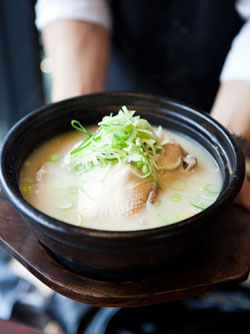 Chicken Paprikash, one of Hungary’s signature comfort food dishes, is made with the country’s quintessential ingredient - paprika. Perhaps not as famous as the better known Goulash, it is still found on nearly every menu and is a common recipe in most Hungarian homes. I was in Budapest for the first time a few months ago and loved the city, in fact I’m already planning a return trip.
Chicken Paprikash, one of Hungary’s signature comfort food dishes, is made with the country’s quintessential ingredient - paprika. Perhaps not as famous as the better known Goulash, it is still found on nearly every menu and is a common recipe in most Hungarian homes. I was in Budapest for the first time a few months ago and loved the city, in fact I’m already planning a return trip.
Condé Nast Traveler recently published its annual Readers' Choice Awards and the "30 best cities in the world" list, which named Budapest, Hungary, as the second-best city in the world, right below Florence, Italy. It’s no wonder – a thriving vibrant city, rich in culture, a complex history, world renowned spas, and gorgeous architecture – there’s something for everyone in Budapest. Although it helped to have some friends who live in Hungary, I found the city easy to navigate and fun to explore, and I recommend it to anyone looking for a new travel destination.
After researching a few hotels, I opted for the relatively new Aria Hotel Budapest, a stately 19th century bank building transformed into a luxurious boutique hotel centrally located just down from St. Stephen's Basilica. After settling into my spacious and modern music themed “Leonard Bernstein” room, I headed downstairs to Aria’s Satchmo's Bar (which offers both lunch and dinner served either inside or outside on the terrace) to meet with Balázs Váradi-Szabó and learn about the hotel’s cuisine. Balázs, their incredibly knowledgeable food and beverage manager, explained that the current menu in many ways reflects the hotel itself – “classic Hungarian with a modern twist.” Patrons hoping to sample the famed Paprikash can expect a deconstructed version which can be found on their inspired menu as a warm appetizer - the “Hortobágyi éclair” features tender paprika chicken wrapped in a soft crepe-like pastry.

 Stuffed and sated without the ability to eat even one more bite – or so I thought – we headed to Hwang Hu Sam Gye Tang restaurant to experience Samgyetang, a hot bowl of bubbling chicken soup made with one very important ingredient: ginseng.
Stuffed and sated without the ability to eat even one more bite – or so I thought – we headed to Hwang Hu Sam Gye Tang restaurant to experience Samgyetang, a hot bowl of bubbling chicken soup made with one very important ingredient: ginseng. Spicy and tropical flavors always transport my imagination to lush jungles or azure beaches belonging to more temperate climates. Mexican food in particular has that effect on me. At home whenever I want to add a south-of-the-border touch to recipes I reach for dried chiles. Ancho chile powder, made of ground dried poblano peppers, lends a smoky and earthy flavor to recipes (think of the many famous mole sauces). Combine it with lime juice and oil and you have the perfect Mex-like marinade for meat or fish. In this case it's shrimp, briefly marinated and then grilled. Paired with a fresh salsa, it's a summery dish that serves well as a quick appetizer when friends stop by.
Spicy and tropical flavors always transport my imagination to lush jungles or azure beaches belonging to more temperate climates. Mexican food in particular has that effect on me. At home whenever I want to add a south-of-the-border touch to recipes I reach for dried chiles. Ancho chile powder, made of ground dried poblano peppers, lends a smoky and earthy flavor to recipes (think of the many famous mole sauces). Combine it with lime juice and oil and you have the perfect Mex-like marinade for meat or fish. In this case it's shrimp, briefly marinated and then grilled. Paired with a fresh salsa, it's a summery dish that serves well as a quick appetizer when friends stop by.